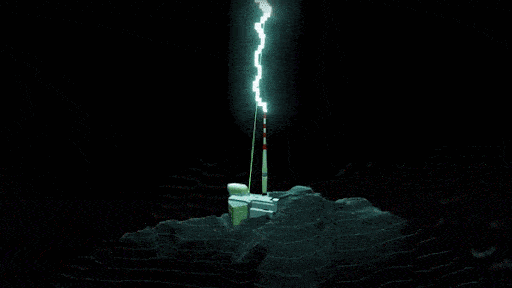The tech that would’ve made Back to the Future five minutes long

Image: Scientify/University of Geneva
Potentially dangerous lightning strikes can be diverted to a safer path by beaming a high-powered laser into the sky, per a new peer-reviewed study published yesterday in Nature Photonics. Or in other, more colloquial terms – humans can now guide the power of Thor using *Dr. Evil voice* frickin’ laser beams.
⏪ Let’s start at the beginning… The concept of using laser beams as lightning rods is nothing new – scientists have been salivating over the possibility since the laser was first invented in 1960. And lightning rods could certainly use an update: the tech currently in use is modeled after Ben Franklin’s original design from the mid-1700s.
The idea behind using a laser is that short, high-power pulses from said laser can superheat the air in its path, making the particles more electrically conductive and creating a safe route for the lightning to travel into the ground. But up until now, experiments in the field had proven unsuccessful.
⛰️ Which brings us to Monday’s study: Where a team of international researchers, using a new car-sized laser lightning rod prototype assembled atop the peak of a Swiss mountain, successfully diverted four lightning bolts.
And similar to Formula 1, the key to success was just to go faster than everyone else. Per the researchers, the key breakthrough in this experiment was significantly upping the laser’s firing speed from previous attempts (by ~100x).
But also like Formula 1, it’s easy to tell things to go fast – and harder to make it happen. The laser lightning rod prototype used in the experiment cost $2.2 billion to build, and was required to fire a record 1,000 pulses per second to pull off the successful attempt.
⚡ Zoom out: Roughly 100 lightning strikes occur around the world every single second. Collectively, these cause thousands of casualties and billions of dollars in damages each year (including $1.3 billion in the US in 2021).
Share this!
Recent Science & Emerging Tech stories

Science & Emerging Tech
| January 11, 2023The secret behind Roman concrete has finally been revealed
💪🏗 The strength of Roman concrete can be attributed to a special mixing process called “hot mixing,” which allows buildings made with the material to literally repair themselves, per a new peer-reviewed study.

Science & Emerging Tech
| January 10, 2023Humans and babies, a history
🧒 Attention, parents – you can now see how you stack up vs. the history of humanity. Per a new peer-reviewed study, researchers at Indiana University have developed a method that can determine the average age humans had children throughout our species’ history.

Science & Emerging Tech
| January 9, 2023The best of CES 2023
👥 Around 100,000 tech enthusiasts gathered in Vegas over the weekend for CES 2023, an annual affair that bills itself as the most influential tech event in the world.
You've made it this far...
Let's make our relationship official, no 💍 or elaborate proposal required. Learn and stay entertained, for free.👇
All of our news is 100% free and you can unsubscribe anytime; the quiz takes ~10 seconds to complete